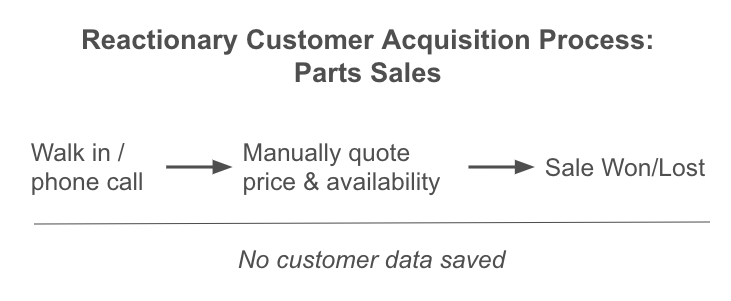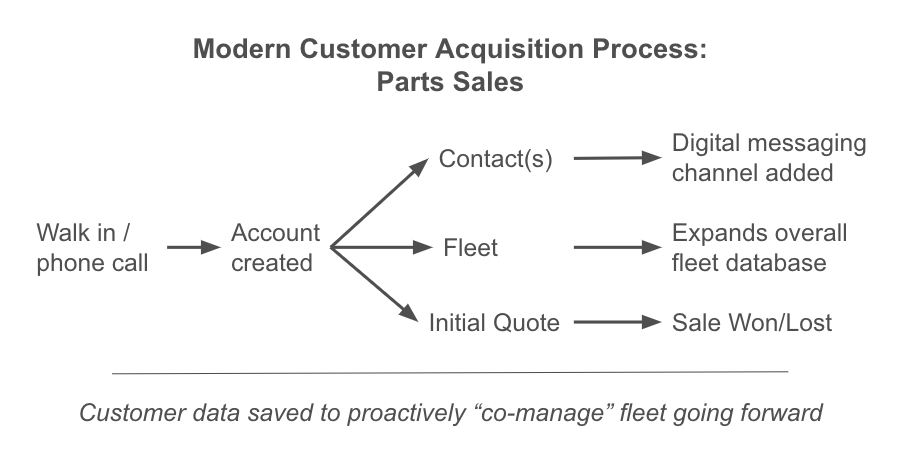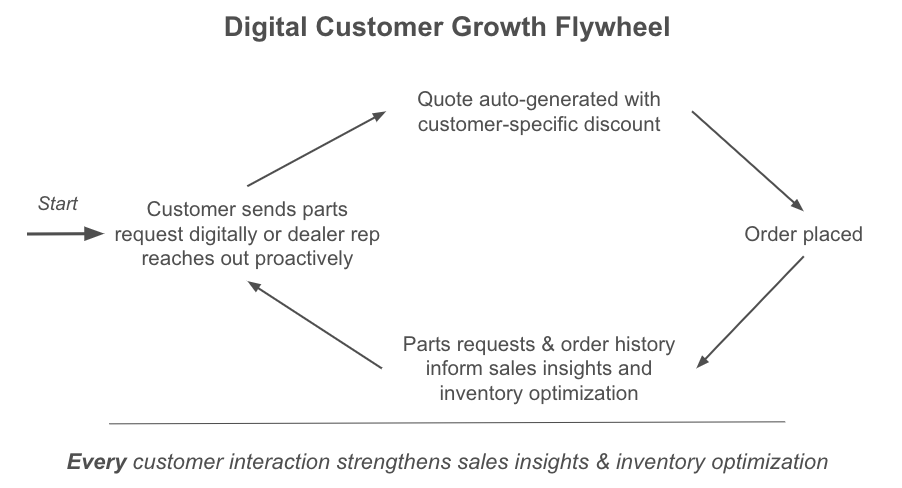Heavy equipment owners' expectations are evolving, particularly when it comes to managing mixed fleets.
They wonder: why is it that when we order for ourselves as consumers we have a seamless, modern experience, yet it feels like 1995 when we use digital tools at work?
Fleet teams want a modern, data-driven approach to inform their purchasing decisions and optimize their parts and maintenance processes by enhancing the personalized support from their various dealers.
But due to the offline nature of our industry, this is an area that is in need of a quantum leap in improvement.
What has traditionally been viewed as a challenge, we see as a tremendous opportunity for parts manufacturers and vendors to take the industry from a reactionary position to a proactive position – actively engaged with their end-user customers before breakdowns occur, delivering timely insights, and “co-managing” their fleets. Labor constraints, supply chain restructuring, and profit pressures seem here to stay for contractors.
Thus, the construction equipment industry is in the middle of a seismic shift to meet the demands of the hardworking men and women who depend on the uptime of their equipment.
On the other side of this seismic shift are closer working relationships, far less unexpected breakdowns, longer equipment life cycles, and unbounded growth for the entire equipment triangle (OEMs, dealers, and contractors).
Let's dive in.
The Evolving Fleet Customer
Today's consumers differentiate between personal and professional decision-making:
- Known-Known Decisions (Personal): As consumers, we have clear needs with readily available information online, leading to well-defined purchase journeys to make decisions quickly (e.g., buying shoes, household items, groceries, etc). Today’s internet caters to our known-known decision-making needs. Yet, when we go to work it’s a different story.
- Known-Unknown Decisions (Professional): Equipment owners managing mixed fleets face complex daily scenarios with limited information, requiring significant internal and external coordination to help answer questions (e.g., What parts are needed in this instance? Do I need approval? Does my dealer need a picture and the machine information? What machine does this invoice go to? What is the tracking information? etc).
Solving these questions to make informed decisions happens many times per day. It’s a relentless, frustrating grind. It also leaves no time to improve the health of the fleet — just to be reactive to the continual stream of issues.
The differences are real, yet we simply want our professional work decisions to be just as straightforward as our consumer decisions. And why not? These are machines we are dealing with after all, and a machine IS a database comprising 1,200+ parts.
Yet the equipment owner is oftentimes left to search for the right parts from a parts manual hundreds of pages long or contact their dealer. A recent industry study found that 9 out of 10 parts transactions are done in person at the parts counter or over the phone.1 Meaning customers are making near-daily treks to and from dealerships to get their parts — non-billable time that has significant delay impacts to the job site.
To put in perspective just how important time is to a job site, consider that Ajax Paving Industries of Florida factors their downtime costs for an asphalt paver on a per-minute basis:
$234/minute ($112K/day)
The Gap Between Customers and Parts
From the perspective of the broader B2B economy, the trend is clear:
“Studies show that 83% of B2B buyers prefer to do business online rather than through a salesperson or other outlet.” U.S. Chamber of Commerce
Think of “online” less like the ecommerce, consumer-based paradigm we know, but more like ease-of-transaction software. Due to the complexities of managing mixed fleets in construction, contractors desire a:
- Smoother Experience: A consolidated, streamlined process for maintaining their diverse fleet.
- Modern Approach: Solutions that leverage technology and data for efficient problem solving.
And equipment dealers know it.
A recent survey from TPS2 asked dealers, “If you were not limited on time and money, which part of your business would you most like to improve?” A whopping 58% of dealers chose “Customer-facing technology (relationship management)” as their No. 1 or 2 choice. Followed immediately by “Parts/service department” with 57%.
It’s safe to assume that the ideal choice would be to combine these two areas — modernizing their customer-facing technology in parts and service.
The Future: Data-Informed Maintenance Decisions
At Gearflow, we have a burning passion for the future of the construction equipment industry.
We believe the industry is in dire need of digitization to unlock productivity and growth for the entire Equipment Triangle: contractors, dealers, and manufacturers.
Parts transactions are happening much slower today than they could be. Customers are solving for the HUGE economics of equipment downtime and want to do more business with their dealers.
Equipment manufacturers and dealers play a crucial role in bridging this gap by facilitating data-driven decision making for preventative maintenance. Here's how:
Phase 1: Fast, Seamless Coordination System
- Transition the 9 out of 10 Walk-in & Phone Call Transactions into a Seamless Experience
- Customers want a better way to do business with their dealers, and their dealers want relationship management technology. Let’s start there.
- Create customer profiles for every account with:
- Real-time messaging on every request for quote (RFQ) and order
- Complete fleet information with images
- Quote and purchase histories
- A reporting suite to leverage actionable sales insights on every account
- Visually, here’s how the workflow would evolve:

In the current parts process, customer needs are pressing and transactional for dealers:

This prevents the opportunity to get out in front of future customer needs to proactively “co-manage” their fleet. Let’s consider what an ideal, modern parts workflow would look like:
 In an ideal workflow, all customer contact information, communication, images, fleet, quotes, and orders are saved to a central database. These would be the baseline to form proactive relationships with customers centered around:
In an ideal workflow, all customer contact information, communication, images, fleet, quotes, and orders are saved to a central database. These would be the baseline to form proactive relationships with customers centered around:
- Ongoing, Instant Communication:
- Real-time coordination between dealers and construction companies.
- OEMs can analyze data from a wide range of equipment, leading to faster identification of common issues and quicker solutions.
- Dealers will have the ability to notify fleet managers about recommended repairs before breakdowns occur.
A seamless, digital coordination system unlocks a beautiful customer growth flywheel:

Phase 2: Intelligent Parts Management and Optimized Machine Life Cycle
- Prescriptive Maintenance Recommendations:
- Based on real-time data and historical maintenance records, the system will recommend the specific parts needed before a breakdown occurs.
- This ensures critical parts are readily available at the dealership, minimizing downtime and maintenance costs.
- Advanced Maintenance Cost-Curve Analysis:
- By analyzing maintenance data and repair costs over time, the system can predict the optimal time to sell a machine.
- This helps equipment owners make informed decisions about their fleet, maximizing return on investment.
- In turn, it would flag the dealership for optimal times to sell a new machine to replace the customer’s existing one.
- Leveraging AI and Machine Learning:
- Equipment armed with sensors that collect real-time data on performance, engine health, and component wear.
- AI algorithms analyze this data to identify anomalies and predict potential failures before they occur. This allows dealerships to address issues proactively, minimizing downtime.
Phase 3: Connected Ecosystem for Informed Transactions
- Turn-key Equipment Maintenance Database:
- A secure, centralized database will store comprehensive maintenance records for all construction equipment.
- This will provide buyers and sellers with a transparent view of a machine's history, facilitating informed decisions during transactions.
Overall Impact to the Construction Industry
These three future phases of construction equipment maintenance will lead to:
- Improved Customer Satisfaction: By addressing known unknowns proactively, businesses can offer a smoother experience for their customers.
- Reduced Downtime: Predictive maintenance minimizes unexpected breakdowns and keeps fleets consistently operational.
- Cost and Parts Management Optimization: Data-driven decisions help prioritize repairs and avoid unnecessary maintenance.
- Improved equipment life-cycle management through data-driven insights.
This transition will require collaboration between equipment owners, equipment dealers, equipment manufacturers, and technology providers to develop and implement these advanced maintenance solutions.
By leveraging a data-driven approach, OEMs and their dealers can bridge the gap between known and unknown customer needs, unlocking closer working relationships and the next growth cycle for the entire equipment triangle.
Let’s make it happen!
Sources:
- MacKay & Company, AEMP Connect presentation, March 2024
- TPS, Trucks, Parts, Service magazine: 2024 Dealer, Distributor, and OEM Component Supplier Outlook, page 27